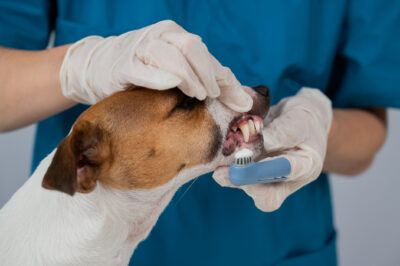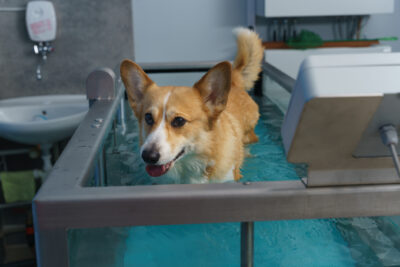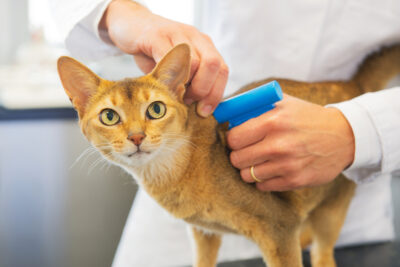Is Peppermint Oil Safe for Dogs?

Overview
Peppermint oil is only safe for dogs when it is diffused properly and used under the direction of your veterinarian or an integrative veterinarian. Peppermint essential oils can be toxic and even fatal to dogs if pet parents choose poor-quality products or use the products incorrectly. For this reason, we do not recommend using peppermint oil on your dog or giving your dog peppermint oil without speaking to your veterinarian first.
Essential oils are becoming more popular among pet parents. They are the compounds extracted from the seeds, roots, leaves, resin, bark or flowers of aromatic plants, making them more concentrated than the plant itself. They are easily absorbed through the skin or by breathing them in. However, there is a lot of fear around whether essential oils are safe for dogs.
One common essential oil is peppermint, since it has many therapeutic benefits for humans. But is peppermint oil safe for dogs? This article explains whether pet parents can use peppermint oil for dogs and offers important safety tips to consider.
What Is Peppermint Oil?
Peppermint essential oil comes from the Mentha piperita plant, which is a perennial herb. Peppermint belongs to the mint family of plants, which also includes spearmint and field mint. This essential oil is steam distilled from the leaves, stems, and flower buds of the peppermint plant. Peppermint contains a high concentration of menthol. Menthol provides the cooling sensation you feel in your mouth when ingesting peppermint or on the skin when applied topically.
Due to the higher concentrations of menthol in peppermint, this provides stronger anti-inflammatory properties to help with muscle aches and soreness. A study in humans found that topical application of peppermint oil was as effective as 1000 mg of acetaminophen [1]. The peppermint oil reduced the intensity of the headache within 15 minutes of application and lasted over an hour.
Peppermint oil is also frequently used to help digestion. Menthol has antispasmodic effects, which help reduce cramping and discomfort. Peppermint oil also has anti-nausea properties, which has made this oil popular for treating IBS in people.
Is Peppermint Oil Safe for Dogs?

Essential oils – especially peppermint oil – have been labeled as being toxic and harmful to dogs. However, when essential oils are used appropriately and at the right dosage they can be helpful to pets.
There are different ways that peppermint oil can be used for dogs. These include applying a diluted solution topically, inhaling the oil through a diffuser, or ingesting them (which should only be done under the direction of your veterinarian). When poor quality essential oil products are used that contain synthetic peppermint or other adulterants (caused by the practice of secretly mixing a substance with another), this is where adverse side effects in dogs occur.
To ensure the safety of peppermint oil for dogs, it’s imperative that pet parents use products from ethical companies. This means that brands make products that are non-adulterated and do not contain additives. Essential oils should also have a batch number on the bottle, have additional testing to show that there are no additional additives, fungal or bacterial overgrowths, and that the bottle contains what it should. The bottle should also have the name and scientific name of the essential oil and source country where the oil was distilled. These are all important for knowing if the company is safe to use first and then the appropriate dilute dosage can be used for dogs to keep them safe.
A safe brand to start with includes AnimalEO which is formulated by an integrative veterinarian.
Puppies are more sensitive to essential oils. Working with a certified animal aromatherapist is recommended prior to using peppermint essential oil with puppies to keep them safe. Otherwise, it is best to avoid peppermint essential oil in dogs, until they are at least 6 months of age.
How to Use Peppermint Oil for Dogs

Because peppermint oil is a very strong, potent essential oil, less is best. The most dilute way to use peppermint essential oil is to diffuse one drop of a good quality product in an open room where the dog can come and go as they want.
Using a 0.5%-2% dilution (1 drop in 1-2 tsp of carrier oil or in a diffuser) is important to keeping dogs safe. Safe carrier oils include olive, jojoba, avocado, sweet almond, and coconut oil.
Applying essential oils topically is the next strongest form of using essential oils and is not recommended unless working with a qualified animal aromatherapist or integrative veterinarian experienced with essential oils.
Due to the strong nature of peppermint essential oil and the cooling sensation from menthol, do not give peppermint oil orally unless it has been heavily diluted and you are working in partnership with your veterinarian.
If there are concerns with using essential oils, dried or fresh peppermint herb can actually be offered to the dog in small amounts (under 1 teaspoon per day), since this form is less concentrated than essential oils and is always safe.
Can Peppermint Oil Be Used for Fleas on Dogs?
Peppermint oil is commonly used in natural flea repelling formulas for dogs due to its insect repelling properties. However, peppermint oil is not strong enough to kill or prevent a flea infestation by itself.
There are brands that utilize natural flea remedies that are effective and safe for your pets.
Peppermint Oil for Dogs: Risks and Side Effects

Peppermint essential oil is absorbed quickly through the skin if applied topically or when inhaled or ingested. If the wrong dosage or a poor quality company and product is used, there is a risk of adverse reactions occurring.
Allergic reaction to peppermint oil is possible. Irritation may also occur if undiluted peppermint essential oil is placed on mucous membranes, in the eyes, or on irritated skin. If this happens, do not try to rinse the oil off with water. Essential oils are lipophilic, meaning they will bind to oils or high fat liquids (like milk). Apply a carrier oil, like olive oil, jojoba, or another oil that does not have any essential oils in it and apply to the affected skin to help soothe and draw the essential oil out.
Inhalation of the oil can cause breathing issues, and younger dogs may be more susceptible. If your dog is having trouble breathing or you notice excessive salivation, squinting, and rubbing at the eyes, first turn off the diffuser (if that is what was being used), open the windows, and take your dog outside on a leash for 10 minutes. Usually this is enough time to allow them to return to normal. If there is any concern, please call your veterinarian or the closest emergency veterinary clinic for advice.
If a high dosage of a poor quality peppermint essential oil was used or given internally, there is potential for death. You should speak with your veterinarian before giving any peppermint essential oil to your dog.
Pet Products That Contain Peppermint Oil

Many pet products for dogs will contain peppermint oil in them for either flavor or smell. Common products include dog toothpaste, dental sticks, water additives, and even dog shampoos, especially ones that are being used for insect repelling properties and allergies. Unfortunately, many companies are using synthetic peppermint oil which can increase the risk of adverse reactions occurring.
Peppermint oil should be listed on the products label if present. Call the company and ask where the essential oil is being sourced, what is the concentration of peppermint oil in the product, if it is an organic product, and if they have the certificate of analysis to show that further studies have been done to prove the safety of the essential oil being used in the product.
These pet product companies are using peppermint oil for the minty smell we expect in dental products, but also for the natural anti-inflammatory properties and natural flea-repelling properties peppermint possesses when used in a pure form. When high quality sources are used, adding peppermint oil into the product can provide health benefits for dogs.
References:
- Göbel H, Fresenius J, Heinze A, Dworschak M, Soyka D. Effektivität von Oleum menthae piperitae und von Paracetamol in der Therapie des Kopfschmerzes vom Spannungstyp [Effectiveness of Oleum menthae piperitae and paracetamol in therapy of headache of the tension type]. Nervenarzt. 1996 Aug;67(8):672-81. German. doi: 10.1007/s001150050040. PMID: 8805113.
- Morag, Nayana. The Aromatic Dog: Essential oils, hydrosols & herbal oils for everyday dog care: A Practical Guide . Off The Leash Press. Kindle Edition. 2015.
- Ingraham, Caroline. The Animal Aromatics Workbook. 2nd Edition. 2006.









